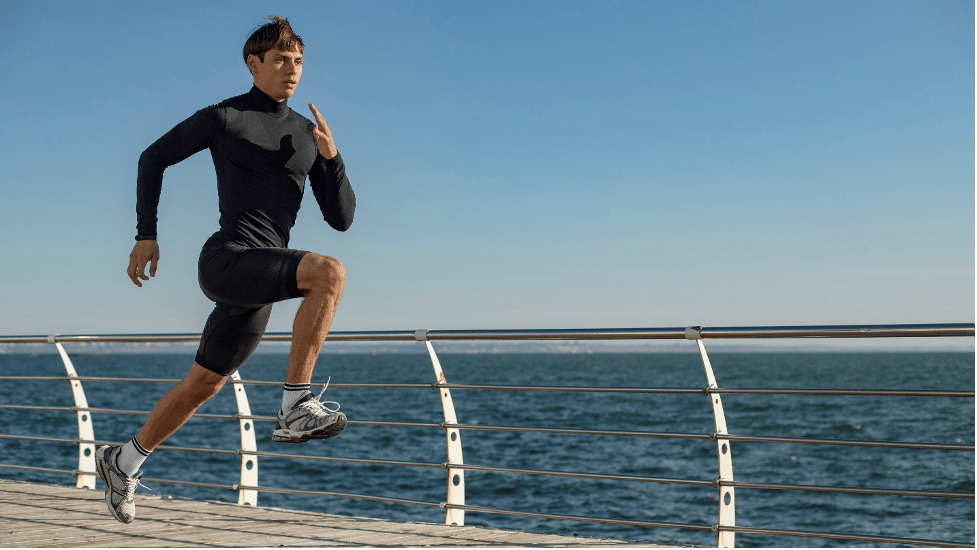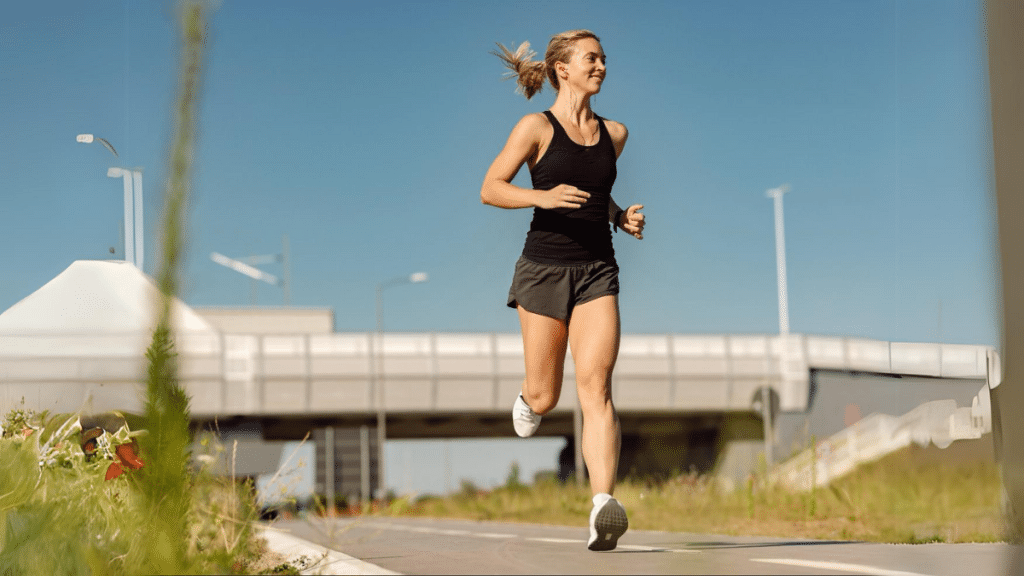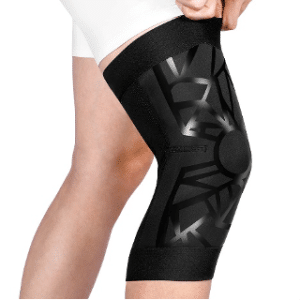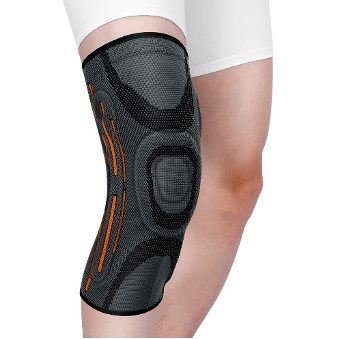Should I wear a knee brace while running? Many avid runners, like you, are wondering this question, as knee pain is a common injury scare for every runner.
Data shows that 25% of males and 30% of female runners [1] suffer from this injury in one form or another. Athletes suffering from runner’s knees or those anxious about the risk of this misery find themselves in big trouble.
So, is wearing a knee brace going to help or not? What does a knee brace do when I am running? And how do I choose the right running knee brace that suits me? These are some frequently asked questions bothering joggers’ minds.
Don’t worry. This article will provide comprehensive information to answer the ultimate myth in the running field: Should I wear a knee brace while running?
Things about Knee Braces That Every Runner Should Know
Understanding Running Knee
How the Knee Works During Running?
When you start to run, multiple muscle groups, joints, and organs kick in to prepare you for this activity.
Your knee is especially important in running, and it is not as simple as you think. Your knee is a network of muscles, ligaments, and cartilage that work together to control movement and provide stability while racing with the wind or just jogging at a relaxed pace.
Your knee also serves as a shock absorber. As your foot strikes the ground, it exerts force on your knee. To dissipate these forces and reduce the damage to your bones and tissues, your knee naturally bends and flexes as the ligaments and tendon stretch and muscles activate.
However, you could still catch running injuries. Why is that, and what injuries are they?
What are Studies on Running-Related Injuries Saying?
Even though our bodies are amazing at protecting us from injuries, things still could go awry. There are some prime factors to watch out for.
- Overuse: Frequent and high-intensity forces added to the knee joint from running can cause micro-traumas in the knee joint and surrounding tissues. They might accumulate over time without adequate rest and recovery, resulting in injuries such as
- Improper Form: Poor running form, such as overstriding, improper foot strike, and loose core area, will fail the body’s natural running mechanics and place extra impact forces on the knee unevenly.
- Muscle Imbalance: Weak or tight muscles surrounding the knee due to inadequate training and adaption can fail to provide the necessary support and stability, resulting in increased stress on the joint.
- Genetic Disposition: Some individuals may have genetic factors that make them susceptible to certain knee injuries.
- Environmental Factors: Inappropriate shoes and uneven surfaces can cause your knees to take a real pounding. Extreme temperatures or humidity might also mess up your muscle function and hydration levels, limiting your body’s ability to protect the knee.
According to a study in the Journal of Sports and Health Science [2], the knee is one of the areas with the highest proportion of injury incidence and injury prevalence among ultramarathoners and non-ultramarathoners alike.
Some common knee injuries from running can include:
| Injuries | Proportion Of Injury Incidence | Injury Prevalence |
| Runner’s Knee | 6.3% | 16.7% |
| IT Band Syndrome | 5.1% | 7.9 % |
| Stress Fracture | 4.0% | 5.7 |
Runner’s Knee: Causes, Symptoms and Treatments
Runner’s Knee, or PFPS, is one of the most prevalent injuries and causes of pain from running. It is often the result of structural defects, misalignment, overuse, and muscle imbalances around your knees.
People with a runner’s knee injury might feel pain during physical activity, have a sensation of grinding or popping in the knee, and have tenderness around the kneecap. Sometimes, swelling around the knee joint can also be a sign.
Recovery may take a few weeks to a few months for early symptoms. Rest, ice, and compression are great ways to ease the discomfort, and modifying activities also helps.
As knee braces are recognized more widely, runners suffering from this injury often ask whether they should wear one while running. Are knee braces also effective solutions?

Should I Wear a Knee Brace While Running?
You may ask if I should wear a knee brace while running and if knee braces help with running. The answer to both these questions is a big yes.
Knee braces benefit runners recovering from injuries or aiming to prevent injuries.
These devices offer several benefits, including:
- Enhancing running performance by providing knee stability
- Improving joint alignment and correcting biomechanical issues
- Minimizing impact and stress on the knee during high-intensity workouts
- Reducing the risk of knee injuries during physical activities
- Offering pain relief from existing knee conditions
- Supporting healing and recovery of knee injuries
How to Choose the Right Running Knee Brace?
Not all knee braces are the same. That is why checking on different factors before making a final call on whether I should wear a knee brace while running is important.
Factors to Consider
1. Support and Stability
Knee support and stability vary depending on your previous injury profile and the level of discomfort. As a rule of thumb, the brace should reinforce the knee without overly restricting your movements so that you can run safely and stable.
2. Flexibility and Range of Motion
Your knee brace must not impede your knee’s natural range of motion more than necessary. A good brace balances support with flexibility, eventually helping you to maintain your running stride and technique effectively.
3. Comfort and Breathability
Since running is a high-intensity activity, flexible, soft, and breathable materials should be the top priority for knee braces.
Running Knee Brace Types and Applications
| Knee Brace Types | Application |
| Knee Compression Sleeves | l Ideal for overall knee support l Alleviates pain during and post-exercise l Mitigates symptoms of arthritis, tendonitis, and general knee discomfort |
| Patellar Stabilizing Braces | l Designed for individuals with patellar alignment problems l Addresses runner’s knee and kneecap dislocation concerns l Ensures proper tracking of the patella |
| Functional Knee Braces | l Aids in the recovery from significant knee injuries such as ACL, MCL, or meniscal tears l Supports a safe return to running activities l Prevents further injury by ensuring knee stability during recovery |
Tips for Using Knee Braces Effectively While Running
As you seek an answer to whether to wear a knee brace while running, you must know how to use these braces effectively for the best results.
Here is what you need to know:
. Ensure Proper Fit And Adjustment
A knee brace that is not properly fit is even worse than no knee brace. A well-sized brace should encircle the knee properly, and any straps or fastenings should be tightened to ensure uniform pressure distribution.
Before buying, you should measure the circumference of your knee correctly. The seller’s website provides guidance on measuring and size choices.
Material is also important for comfort and fit. Choose materials that are flexible and breathable.
After purchase, you should learn how to adjust the brace for a customized fit. Wear the brace on and check if it remains in place without sliding and if it causes discomfort at the edges.
. Integrate Braces Gradually and Smoothly into Running Routine
Start with shorter, less intense running sessions to allow your body to adapt to the additional support of braces.
Be mindful of any alterations in your running gait and make corrections as necessary to prevent the formation of poor running habits.
If running with the brace leads to new or heightened discomfort, pause to evaluate the situation and seek help from the seller or professional therapists.
. Regular Maintenance for Optimal Performance and Lifespan
Like other fitness gadgets, knee braces also require proper maintenance.
- Proper Cleaning: clean according to the manufacturer’s instructions on the care label. Hand washing with mild soap and cold water is often recommended.
- Air Dry: After cleaning, let the brace air dry completely to avoid heat or direct sunlight damage.
- Lubricate Hinges: If your brace has moving parts and they are somewhat stuck recently, lubricant can be the solution.
- Store Properly: When not used, store the brace in a dry, cool place away from direct light and heat sources.
Popular Knee Braces for Running Recommendation
FIVALI is a famous name among fitness enthusiasts and athletes. The company is driven by a core mission to keep you active and safeguarded against injuries.
Born from a passion for physical fitness shared by its creators, Fivali deeply understands the needs of its community. FIVALI’s state-of-the-art running braces will help you answer the question: Should I wear a knee brace while running?
| Fivali Compression Sport Knee Sleeves for Running | |
|
|
|
| Fivali Compression Running Knee Brace for Pain | |
|
|
|
Conclusion
After reading all these, we hope you have found the answer to the long-standing question “Should I wear a knee brace while running?”.
Save your knee from the miserable fate that may come without these braces or by using low-quality braces. Knee braces can be a valuable investment for runners seeking to prevent injuries or manage existing ones.
Choosing a well-fitting, comfortable brace and maintaining it properly can enhance your running experience and promote knee health. FIVALI brings a range of knee braces designed to empower your runs with confidence and protection. Choose FIVALI now to embark on a new running journey.
Reference
[1] Temple Health. What Are Common Knee Injuries from Running? Available from https://www.templehealth.org/about/blog/common-knee-injuries-running. (Accessed on March 28, 2024)
[2] Nicolas Kakouris, Numan Yener, and Daniel T.P. Fong. “A Systematic Review of Running-Related Musculoskeletal Injuries in Runners.” Journal of Sport and Health Science. Available from https://www.ncbi.nlm.nih.gov/pmc/articles/PMC8500811/. (Accessed on March 28, 2024)



